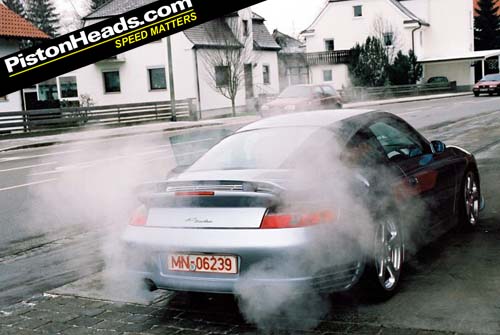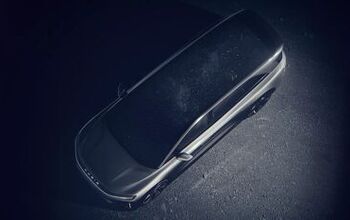RUF-R Turbo Review
The snow falling from the leaden sky over Pffanhausen made me nervous. As did the fact that Natalie Campagna, Keeper of the Keys for RUF Automobile De, couldn't look me in the eye. And no wonder: Alois Ruf himself had just called to forbid the English journalist from driving the R-Turbo. On the face of it, it was an entirely sensible decision. Five hundred and twenty horsepower and drifting snow are not the ideal combination for a test drive- especially when the car in question belongs to a customer.
Plan B involved a ride in the passenger seat with a RUF technician at the helm, followed by a 'small spin behind the wheels.' As I helped push the immaculate R-Turbo out of the showroom, I hoped something had been lost in the translation. I took comfort in the fact that RUF's official press car- a yellow, rear-wheel-drive machine-was busy making sushi out of lesser cars in Japan. This silver car had four-wheel-drive and stability control. Oh, that's all right then… isn't it?
In coupe form, the latest Carrera is easily Porsche's most elegant design. Ever. Despite the engineering complications involved, RUF's decision to shoehorn a turbo engine into a standard Carrera body is a stroke of minimalist genius. The narrow-bodied RUF car not only reduces drag, it also makes Porsche's wide-hipped machine look as tacky a diamond-encrusted Rolex. Of course, there are still a few subtle touches to alert the cognoscenti that something wicked this way cometh: quad exhausts, bespoke nose and tail, and triangular intakes carved into the car's haunches. But if you didn't know that the RUF R-Turbo is the world's fastest production car, you wouldn't.
And then Johann Kerler, RUF's Neuwagenchef, twists the key. If bystanders had any doubts that the visually restrained R-Turbo was anything other than monstrous, the car's huge raspy bark would provide an instant re-education. As would the idle, which sounds like nothing so much as the rumble of distant bombers. If you're not interested in how RUF achieves this result, look away now…
Alois and his boys start with a stock 3.6 litre Porsche Turbo engine. They strip it down, replace the valve train, revise the camshafts, modify the VarioCam system and KKK turbochargers, install a by-pass valve exhaust system and re-map the Bosch engine management. They stuff the turbos, intercoolers and related plumbing into a svelte 996 body using Porsche GT3 engine mounts. The power plant is connected to the wheels with the GT2's hollow shaft transaxle, clutch and limited slip differential.
And there you have it: roughly 100 horses more than the official Porsche product, and various bits and pieces to make sure it doesn't break.
On the road, RUF's extreme engineering works seamlessly. Easing down [thankfully dry] sweeping bends, the R-Turbo maintains traditional Carrera virtues. It pulls cleanly from 1500rpms in any gear. The steering, suspension, 6-speed box and chassis work with perfect synergy. From the inside, the R-Turbo looks and feels like a car bought from an official Porsche dealer, sat nav and all. If you enjoy feeling welded to the tarmac, and don't mind commuting to work in GT3 racing seats, the R-Turbo is a thoroughly practical proposition.
Practical, but purposeful. Looking over at the RUF speedometer, I notice that the R-Turbo's gauge has only four increments: 50, 100, 150 and 200mph. Herr Kerler finds a bit of open road. He smiles knowingly, then demonstrates that dispatching the gaps between these numbers is simply a matter of flexing your right foot, waiting a few seconds and avoiding solid objects. The numbers are almost as impressive as the experience. Zero to sixty takes 3.6 seconds. Rest to 100 takes 7.9. Very few cars can create these G-force laden time distortions. None of them can do it with such ridiculous, sure-footed ease.
And then we hit the autobahn. Herr Kerler gingerly negotiates the absurd hairpin onramp, and we're away. Well away. Gone, gone, gone. A few laggards (driving at 100mph or so) impede our progress. Once they move over, it's top end time. As the speedo nudges 190 out of a potential 212mph, the air pressure wave pushes snowflakes out of our way. They fly over the roof, as if to underline the fact that when it comes to speed, nothing can touch this car.
Within minutes, we're 10 miles away. Kerler pulls off the autobahn for the changeover. My initial impressions are confirmed. The steering is direct, the suspension firm but compliant, and the engine tractable. When I give the go pedal a firm push, I'm astounded by the violence of the acceleration. Again. But what's even more impressive is that I'm not the slightest bit scared driving a car on a public highway at 175mph. And that's scary.
Back on the side roads, my confidence increases. With four-wheel-drive and PSM stability control to keep me out of trouble, I can tap into epic power anywhere, everywhere, anytime, all the time. When the revs crest 3500rpms, the turbos spin-up to add the word 'demented' to the pre-existing experience called 'ferocity'. Sure, the stock Porsche Turbo is quick, but the thrills are so linear you hardly notice. If the RUF car was a dance, it would be 'quick, quick, BLOODY HELL!' You get two cars in one: the basic thrust of the stock Turbo and the afterburner lunacy of RUF's conversion.
From a handling point of view, understeer or oversteer are a non-issue. Just point and go. Massive 19' wheels, Brembo brakes, four-piston callipers and a slightly modified Turbo suspension all do their part to keep you in control. At one point, pulling back onto the main road after a few photos, I manage to overcook it. The PSM stability control kicks in. The back end snaps back and forth like a freshly landed fish. In a fraction of a second, while I'm still in my lane, the car sorts itself out. For this, may The Gods of Liability Insurance make me truly grateful.
And this is where the purists scoff. They see RUF's four-wheel-drive R-Turbo as a logical (if maniacal) extension of Porsche's excessive quest for user friendliness. For them, the yellow car, the machine without a safety net, is the one to have. They're wrong. Provided you're not a professional race driver, 520 horses and a curb weight of 3,241 lbs. say you need all the help you can get. Back at base, a relieved Natalie reveals that the majority of R-Turbo buyers agree.
I can only imagine the full glory of the R-Turbo on a dry road. At £117k, the thrills wouldn't be cheap, but they would be safe. Well, more or less. In other words, you don't have to drive the four-wheel-drive R-Turbo in a snowstorm to know it's the fastest yet most accessible uber Porsche ever made. But if you want to, you can.
More by Robert Farago
Latest Car Reviews
Read moreLatest Product Reviews
Read moreRecent Comments
- Kjhkjlhkjhkljh kljhjkhjklhkjh A prelude is a bad idea. There is already Acura with all the weird sport trims. This will not make back it's R&D money.
- Analoggrotto I don't see a red car here, how blazing stupid are you people?
- Redapple2 Love the wheels
- Redapple2 Good luck to them. They used to make great cars. 510. 240Z, Sentra SE-R. Maxima. Frontier.
- Joe65688619 Under Ghosn they went through the same short-term bottom-line thinking that GM did in the 80s/90s, and they have not recovered say, to their heyday in the 50s and 60s in terms of market share and innovation. Poor design decisions (a CVT in their front-wheel drive "4-Door Sports Car", model overlap in a poorly performing segment (they never needed the Altima AND the Maxima...what they needed was one vehicle with different drivetrain, including hybrid, to compete with the Accord/Camry, and decontenting their vehicles: My 2012 QX56 (I know, not a Nissan, but the same holds for the Armada) had power rear windows in the cargo area that could vent, a glass hatch on the back door that could be opened separate from the whole liftgate (in such a tall vehicle, kinda essential if you have it in a garage and want to load the trunk without having to open the garage door to make room for the lift gate), a nice driver's side folding armrest, and a few other quality-of-life details absent from my 2018 QX80. In a competitive market this attention to detai is can be the differentiator that sell cars. Now they are caught in the middle of the market, competing more with Hyundai and Kia and selling discounted vehicles near the same price points, but losing money on them. They invested also invested a lot in niche platforms. The Leaf was one of the first full EVs, but never really evolved. They misjudged the market - luxury EVs are selling, small budget models not so much. Variable compression engines offering little in terms of real-world power or tech, let a lot of complexity that is leading to higher failure rates. Aside from the Z and GT-R (low volume models), not much forced induction (whether your a fan or not, look at what Honda did with the CR-V and Acura RDX - same chassis, slap a turbo on it, make it nicer inside, and now you can sell it as a semi-premium brand with higher markup). That said, I do believe they retain the technical and engineering capability to do far better. About time management realized they need to make smarter investments and understand their markets better.




































Comments
Join the conversation